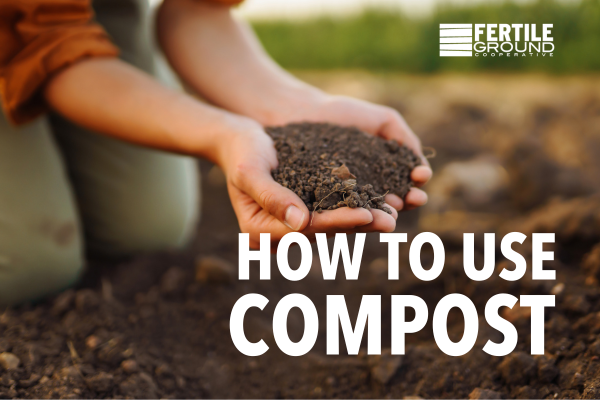How to use compost
There are various ways to use your finished Fertile Ground compost. You can sprinkle compost on top or mix it into your flower and vegetable beds. Gently rake compost into tree beds. Blend it with potting soil to help indoor plants. Or, spread it on your lawn to improve the soil.
Finished compost should look like dark, crumbly topsoil. It should not look like the original materials. Compost should have a pleasant, earthy smell to it. Using “unfinished” or immature material with food scraps can attract pests. It can also harm young plants. So, if you are using compost from your scraps, make sure your compost has fully decomposed before adding it to your garden beds.
Adding compost is like giving your soil a makeover. It amps up soil health and structure, locking in moisture for your plants. Plus, it's a pest-fighting party with earthworms and microbes. And the best part? Your plants get a steady nutrient boost from compost. It's like a secret weapon for a thriving garden!
Amending Soil
Work 1–2 inches of compost into the top 3–5 inches of soil.
Growing Vegetables
Put a handful of compost in each hole when you’re planting. Once plants begin to grow quickly, you can add a half-inch layer of compost around the base of the plants. Provide “heavy feeder” plants such as tomatoes, corn, and squash with 1/2 inch of compost monthly—this will result in great produce!
Growing Flowers
In the spring, loosen the top few inches of annual and perennial beds and mix in a 1-inch layer of compost. Or in the fall, apply a 1-inch layer of compost as a mulch to protect plant roots from freezing and conserve moisture.
Replenishing Soil In Potted Plants & Window Boxes
Even the best potting soil gets depleted of its nutrients as plants grow. To replenish nutrients, add an inch of compost to potted plants and window boxes twice a year. Or, make your own potting soil using two parts screened compost to one part sand or perlite.
Rejuvenating Lawn or Turf
When establishing new turf, incorporate up to 3 inches of compost into the soil and seed directly over it. For bald spots on existing turf, mix an inch of compost into the soil before planting new seeds to fight compaction and suppress soil-borne diseases. Topdress existing turf with up to 1/2 inch finely screened compost, spreading evenly with a spreader or shovel. Rake compost into grass area to allow it to settle into soil, improving structure and providing nutrients, reducing compaction, bald spots, and need for synthetic fertilizers.
Tree and Shrub Planting and Maintenance
When planting a new tree, work 1/2–1 inch of compost into the top 2 inches of soil from the trunk to the dripline (the outermost parameter of the tree’s canopy). Compost enriches soil, provides nutrients, reduces moisture loss, and keeps soil cool. Avoid adding compost to the planting hole to encourage root growth. Use compost as mulch, spread up to 2 inches under the tree or shrub, extending to the drip line or bed edge. Incorporate compost into soil yearly, loosening compacted soil first. Don't put compost/mulch against bark or exposed roots to prevent rot and pests.
Maintaining Perennial & Annual Beds
Spread 1–2 inches of compost on top of perennial and annual beds in the early spring or fall to prevent weeds from establishing and to make plants more drought-resistant.

